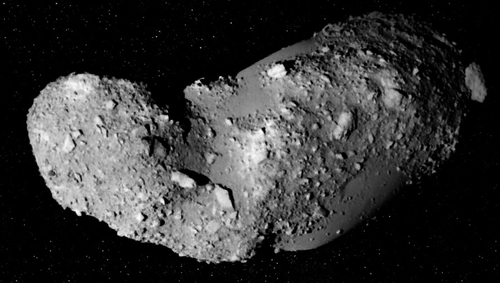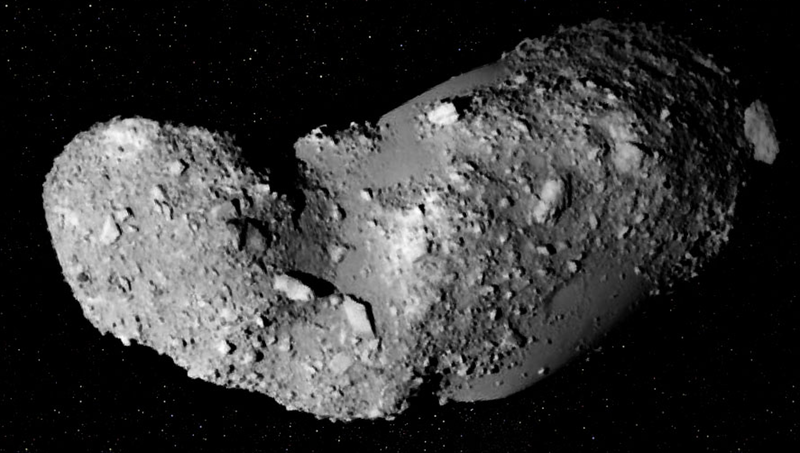Hard and Soft Bounces Explain Asteroid’s Surface Structure
Asteroid Itokawa, an irregularly shaped object measuring only 540 m along its longest axis, has two distinct types of surface, consisting either of small pebbles and dust or of large boulders. A new proposal suggests that these two surface types arose because the particles that strike the asteroid are more likely to bounce away when colliding with boulders but tend to stop dead when hitting a sea of pebbles. The researchers support their idea with simulations and experiments involving beads dropped on rocks. Although the proposed mechanism works most effectively for smaller asteroids, it could also influence the formation of surface features on larger objects, even the terrestrial planets.
Itokawa is a “rubble-pile” asteroid, an agglomeration of rocky solar system debris held together by its own gravity. In 2005, the Japanese probe Hayabusa took close-up photographs that revealed the surprising demarcation of its surface into two types [1]. Surface depressions are filled predominantly with material ranging from centimeter-sized pebbles to fine dust, while higher altitude areas have boulders as large as 40 m across.
There is no widely accepted explanation for this segregation, but Troy Shinbrot of Rutgers University in Piscataway, New Jersey, and his colleagues now offer one based on their simulations and experiments. They note that Itokawa has comparable volumes of large boulders and small pebbles, so that the number of pebbles far exceeds the number of boulders—by a factor of as much as a billion. Itokawa’s formation and growth, therefore, resulted from the cumulative accretion of countless small particles, punctuated by exceedingly rare impacts of larger ones.
If a small particle sailing into Itokawa hits a boulder, it will typically bounce off, either flying away from the asteroid altogether or landing again at some other spot. But if the same pebble falls onto an area of similarly sized pebbles, its momentum and energy will be quickly dissipated through many “knock-on” collisions, and it will come to rest close to where it landed. This difference, the team says, makes it possible to understand why “seas” of pebbles will steadily grow to fill in low-lying areas, leaving large boulders uncovered at higher points on the asteroid’s surface.
A series of lab experiments verified these ideas. First, the researchers dropped 1-mm-diameter glass beads onto a ceramic plate that mimicked a large boulder. Provided the beads were dropped individually rather than poured in a stream, they almost all bounced away, leaving the plate mostly clean. But when a small pile of beads was placed on the plate initially, the beads dropped onto it stayed put, and the pile grew larger.
Next, the team arranged a bed of stones, each a few centimeters across, in a pattern with hills and a valley. They dropped glass beads onto this irregular surface and found that over time the beads filled in the lower lying areas while leaving the higher stones uncovered. To demonstrate that this was not simply the result of beads landing everywhere and then rolling downhill into the valley, the researchers looked at the rate at which the valley filled up. They found that the behavior was consistent with the prediction from a century-old empirical equation capturing the tendency of particles to accumulate on existing particles [2]. But the results were inconsistent with the expected rate at which particles would roll into the valley after coming to rest elsewhere.
Finally, the team conducted computer simulations that allowed them to track the paths of bouncing particles and to vary the strength of gravity. The simulations confirmed that particles bounce off boulders but come to rest on particle seas; they also showed that the mechanism works at very low gravity.
The team says that this size segregation mechanism is likely to be a dominant process for objects with weak gravity that pull in particles at very gentle speeds, but it can have effects in gravity of any strength. The larger asteroids Vesta and Eros (about 500 and 30 km across, respectively) have flat areas, apparently consisting of fine particles, that could have grown in the same way. Bodies with stronger gravity, by contrast, would experience higher-speed collisions that might fling up showers of debris and move or even fracture boulders.
Jonathan Kollmer of North Carolina State University in Raleigh describes the work as elegant and praises it for bringing concepts from the physics of granular materials into a discussion of astrophysics. Since the team’s experiments clearly demonstrate that the size segregation process works in Earth’s gravity, he suggests that it may be important in the formation of structures on larger bodies, perhaps even on Mars.
This research is published in Physical Review Letters.
–David Lindley
David Lindley is a freelance science writer, now retired. His most recent book is The Dream Universe: How Fundamental Physics Lost Its Way (Penguin Random House, 2020).
References
- H. Yano et al., “Touchdown of the Hayabusa Spacecraft at the Muses Sea on Itokawa,” Science 312, 1350 (2006).
- A. V. Hill, “The Possible Effects of the Aggregation of the Molecules of Haemoglobin on its Dissociation Curves,” J. Physiol. 40, iv (1910).





